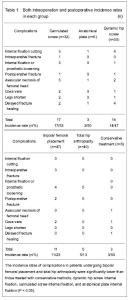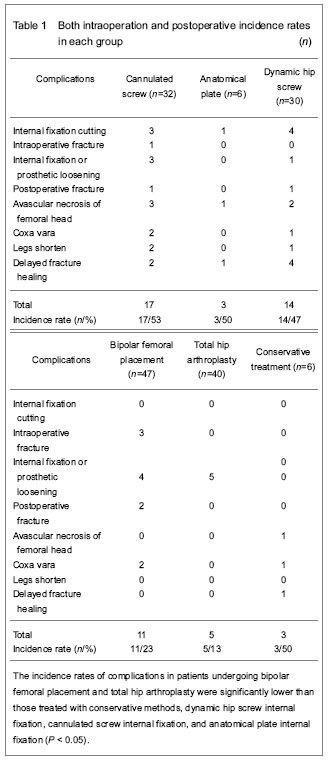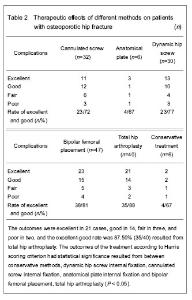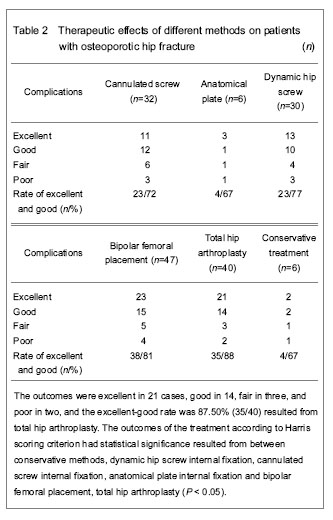| [1] Liu J. The comparison of different treatment method of internal fixation on inertrochanter fracture of femur. Zhongguo Xiandai Yixue Zazhi. 2011;21(19):2283-2285.
[2] Liu ZH. Bone Mineral and Clinical M. Beijing: China Science and Technology Press, 2006:446-460.
[3] Harris WH. Traumatic arthritis of the hip after dislocation and acetabular fractures: treatment by mold arthroplasty. An end result study using a new method of result evaluation. J Bone Joint Surg Am. 1969;51(4):737-755.
[4] Napoli N, Schwartz AV, Palermo L, et al. Risk factors for subtrochanteric and diaphyseal fractures: the study of osteoporotic fractures. J Clin Endocrinol Metab. 2013; 98(2):659-667.
[5] Kung AW, Fan T, Xu L, et al. Factors influencing diagnosis and treatment of osteoporosis after a fragility fracture among postmenopausal women in Asian countries: a retrospective study. BMC Womens Health. 2013;13(1):7-15.
[6] Briongos L, Sañudo S, García-Alonso M, et al. Treatment of osteoporosis and hip fractures in a Spanish health area. Eur Rev Med Pharmacol Sci. 2013;17(2):266-268.
[7] Chen P, Liu WH, Yan LL, et al. Treatment of osteoporotic hip fracture in the elder. Zhongguo Linchuang Xinyixue. 2012;5(5):410-412.
[8] Said GZ, Farouk O, El-Sayed A, et al. Salvage of failed dynamic hip screw fixation of intertrochanteric fractures. Injury. 2006;37(2):194-202.
[9] Zhang C, Wang PJ, Ruan DK, et al. Complications of surgical treatment for femoral intertrochanteric fractures using dynamic hip screw. Zhongguo Gushang. 2009;22(8): 624-626.
[10] Huo JJ, Zhao Y, Tian H, et al. Systematic review on gamma nails versus dynamic hip screws and plate for intertrochanteric fractures of femur in elder. Zhongguo Xiandai Yixue Zazhi. 2011;21(7):773-778.
[11] Jewell DP, Gheduzzi S, Mitchell MS, et al. Locking plates increase the strength of dynamic hip screws. Injury. 2008; 39(2):209-212.
[12] Zheng HG, Tang H, Zhang QL. A comparative study of dynamic hip screw and proximal femoral nail an tirotation in treatment of femoral in tertrochan tericfractures. Zhongguo Jiaoxing Waike Zazhi. 2009;17(6):407-408.
[13] Al-Ani AN, Samuelsson B, Tidermark J, et al. Early operation on patients with a hip fracture improved the ability to return to independent living: A prospective study of 850 patients. J Bone Joint Surg Am. 2008;90(7):1436-1442.
[14] Efstathopoulos NE, Nikolaou VS, Lazarettos JT. Intramedullary fixation of intertrochanteric hip fractures: a comparison of two implant designs. Int Orthop. 2007;1: 71-76.
[15] Parker MJ, White A, Boyle A. Fixation versus hemiarthroplasty for undisplaced intracapsular hip fractures. Injury. 2008;39(7):791-795.
[16] Cui FG, Cong J, Li GS. Treatment of unstable femoral intertrochanteric fracture with dynamic hip screw. Zhongguo Jiaoxing Waike Zazhi. 2008;16(6):471-472.
[17] Leonardsson O, Sernbo I, Carlsson A, et al. Long-term follow-up of replacement compared with internal fixation for displaced femoral neck fractures: results at ten years in a randomised study of 450 patients. J Bone Joint Surg Br. 2010;92(3):406-412.
[18] Li SF. The comparison between different treatment on femoral intertrochanteric fractures by dynamic condylus screw and dynamic hip screw. Zhongyiyao Daobao. 2008; 14(5):63-65.
[19] Gao H. Clinical outcome of femoral head replacement for femoral intertrochanteric fractures or femoral neck fractures in patients over 70 years old. Zhongguo Zuzhi Gongcheng Yanjiu yu Linchuang Kangfu. 2008;12(35):6879-6882.
[20] Frihagen F, Nordsletten L, Madsen JE. Hemiarthroplasty or internal fixation for intracapsular displaced femoral neck fractures: randomised controlled trial. BMJ. 2007;335 (7632):1251-1254.
[21] Guan CY, Chang Q, Ma YZ, et al. Treatment of senile patients with unstable femoral intertrochanteric fracture:comparison between hemiprosthesis arthoplasty and internal fixation. Zhongguo Gu yu Guanjie Sunshang Zazhi. 2008;23(12):975.
[22] Faldini G, Grandi G, Romagnoli M, et al. Surgical treatment of unstable intertrochanteric fractures by bipolar hip replacement or total hip replacement in elderly osteoporotic patients. J Orthop Trauma. 2006;7(3):117-121.
[23] Gu GS, Wang G, Sun DH, et al. Cemented bipolar hemiarthroplasty with a novel cerclage cable technique for unstable intertrochanteric hip fractures in senile patients. Chin J Traumatol. 2008;11(1):13-17.
[24] Hsu CJ, Chou WY, Chiou CP, et al. Hemi-arthroplasty with supplemental fixation of greater trochanter to treat failed hip screws of femoral intertrochanteric fracture. Arch Orthop Trauma Surg. 2008;128(8):841-845.
[25] Ho M, Garau G, Walley G, et al. Minimally invasive dynamic hip screw for fixation of hip fractures. Int Orthop. 2009;33(2): 555-560.
[26] Zhang S, Kong CG, Chen WY, et al. Osteoporotic hip fracture: Comparison on various treatments of metal implants. Zhongguo Zuzhi Gongcheng Yanjiu yu Linchuang Kangfu. 2010;14(22):4176-4180.
[27] Chen JS, Zheng Q, Li H. Comparison of dynamic hip screw and proximal femoral nail for treating intertrochanteric fractures in elderly patients. Zhejiang Yixue. 2008;30(1): 49-51.
[28] Hammad A, Abdel-Aal A, Said HG, et al. Total hip arthroplasty following failure of dynamic hip screw fixation of fractures of the proximal femur. Acta Orthop Belg. 2008; 74(6):788-792.
[29] Hsu CJ, Chou WY, Chiou CP, et al. Hemi-arthroplasty with supplemental fixation of greater trochanter to treat failed hip screws of femoral intertrochanteric fracture. Arch Orthop Trauma Surg. 2008;128(8):841-845.
[30] Faldini G, Grandi G, Romagnoli M, et al. Surgical treatment of unstable intertrochanteric fractures by bipolar hip replacement or total hip replacement in elderly osteoporotic patients. J Orthop Trauma. 2006;7(3):117-121.
[31] Wang CH, Ma ZX, Bi LF. Analysis on osteoporosis diagnosis and treatment of 986 elderly inpatients with hip fracture. Zhongguo Guzhi Shusong Zazhi. 2010;16(5): 353-355. |



